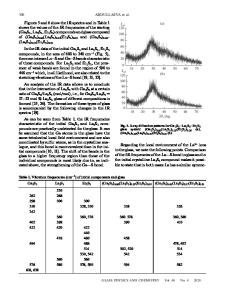Photoelectrochemical cells based on In 2 S 3 single crystals
- PDF / 202,520 Bytes
- 4 Pages / 612 x 792 pts (letter) Page_size
- 47 Downloads / 434 Views
UCTOR STRUCTURES, INTERFACES, AND SURFACES
Photoelectrochemical Cells Based on In2S3 Single Crystals V. Yu. Rud’a^, Yu. V. Rud’b, I. V. Bodnarc, and T. N. Ushakovab aSt.
Petersburg State Technical University, St. Petersburg, 195251 Russia ^e-mail: [email protected] bIoffe Physicotechnical Institute, Russian Academy of Sciences, St. Petersburg, 194021 Russia cBelarussian State University of Information Science and Radio Engineering, Minsk, 220072 Belarus Submitted March 31, 2008; accepted for publication May 21, 2008
Abstract—The single crystals of tetragonal modification t-In2S3 are grown by the planar crystallization of the melt. On their basis, the photosensitive H2O/t-In2S3 cells are fabricated, and the spectra of their quantum efficiency are investigated. The broadband photosensivity of H2O/t-In2S3 cells is determined. On the basis of the photosensivity spectra, the character of interband transitions and the t-In2S3 band gaps corresponding to them are determined. The possibility of using the t-In2S3 crystals in broadband photoconverters of natural and polarized radiations is shown. The relation between the energy spectrum and the phase state of In2S3 crystals is revealed. PACS numbers: 73.50.Pz, 78.20.Ci, 85.30.Hi DOI: 10.1134/S1063782609040046
The study of interatomic interactions in I2–VI–III2–VI3 quasi-binary systems resulted in obtaining I–III–VI2 ternary diamond-like semiconductors, which provided the breakthrough in the field of creation of thin-film solar cells (TSCs) with the unprecedentedly high quantum efficiency (~20%) and radiation stability for these types of photoconverters [1–3]. The multicomponent diamond like semiconductors became the most needed materials in the thin-film photovoltaics [4]. The binary semiconductors III2–VI3 to which In2S3 belongs, remain insufficiently studied until now [5, 6], although, they are of interest as an ecologically safe component of broadband heterophotoconverters, which can replace highly toxic cadmium included in the TSCs based on Cu(In,Ga)(S,Se)2/CdS [7]. The important property of binary compounds III2–VI3 is their recognized polytropy [5]. Until now, the In2S3 crystals of cubic modification [8] were investigated. In this study, we solved for the first time the problem of obtaining the single crystals of the tetragonal crystal system, which enabled us to fabricate the photosensitive structures on their basis and to obtain the first data on the fundamental properties of the In2S3 single crystals of the tetragonal crystal system. 1. The crystals of binary sulfide In2S3 were synthesized by the two-temperature method from more than 99.999%-pure initial components of the basic substance. The batch of metal indium was loaded into the quartz boat, which was arranged at the end of the quartz cell. At the opposite end of this cell, we placed sulfur, the batch of which contained excess sulfur with respect to the In2S3 stoichiometric structure. The excess sulfur provided the maintenance of its partial vapor pressure
of ~2 bar during the synthesis in the cell volume. Aft
Data Loading...











